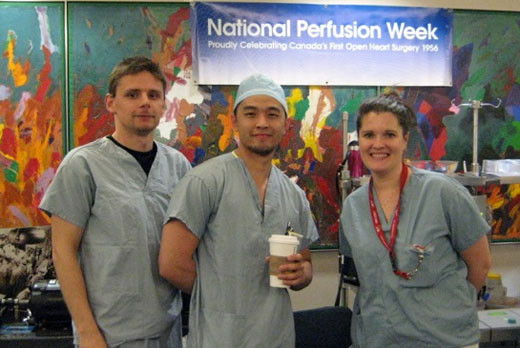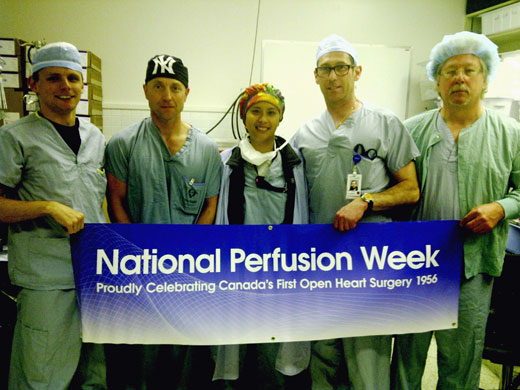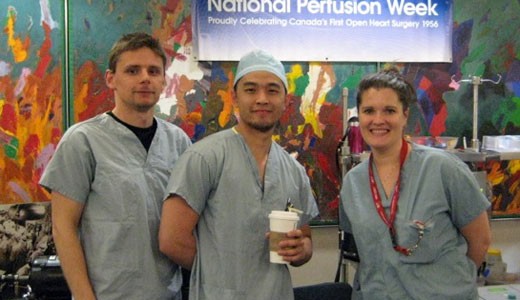An interview with Kim-Long Ta, VGH clinical perfusionist

Celebrating National Perfusion Week (l to r): Doug Israel, Kim-Long Ta and Tara Powers, clinical perfusionists.
At VGH our team of clinical perfusionists recently celebrated National Perfusion Week with informative displays in the main corridor and OR lounge of Jim Pattison Pavilion. More than 180 people — patients, public and staff — visited the displays. The most common question asked: What the heck is a perfusionist, anyway? Kim-Long Ta answers — and shares why he loves his job.
How does a clinical perfusionist spend his or her day?
Kim-Long: A perfusionist manipulates and controls life-saving support devices in the operating room during open heart and transplant surgeries. We set up and operate a cardiopulmonary bypass machine, which replaces the patient’s heart and lung functions while the cardiac surgeon repairs anomalies and disease processes of the heart. A lot can go wrong very fast, and our training and teamwork allows us to troubleshoot and make split-second decisions to maintain safe cardiopulmonary bypass on our patients.
An average work day may also include:
- monitoring patients during various medical procedures, as well as operating blood salvage technologies and cardiac support systems
- performing extracorporeal membrane oxygenation (ECMO), also known as heart and/or lung life support, at the bedside for those awaiting transplant
- providing long-term respiratory support to patients suffering from acute lung diseases

Vital members of the cardiovascular surgical team (l to r): Doug Israel, Rob Chalus, Eleanor Sese, Filippo Berna and Bernie Hanasyk, clinical perfusionists.
How has clinical perfusion changed over the years, perhaps even during the course of your career?
Kim-Long: I can name many advances:
- more efficient and safe technologies built into our equipment
- smaller and more efficient oxygenators (artificial lungs) and blood pumps (artificial hearts)
- a shift towards blood conservation
- drug-eluting coronary stents and minimally invasive coronary artery bypass graft surgeries with robotic harvest
What do you love about your job?
Kim-Long: It’s very rewarding to work in a tight-knit, interdisciplinary team of professionals with a focused goal of helping our patients. There’s a lot of open communication between perfusionists, cardiac surgeons, surgical assistants, anaesthetists and nurses. The realization that you’re keeping a patient alive through the heart-lung machine, while the surgeon is operating on the heart, is empowering.

